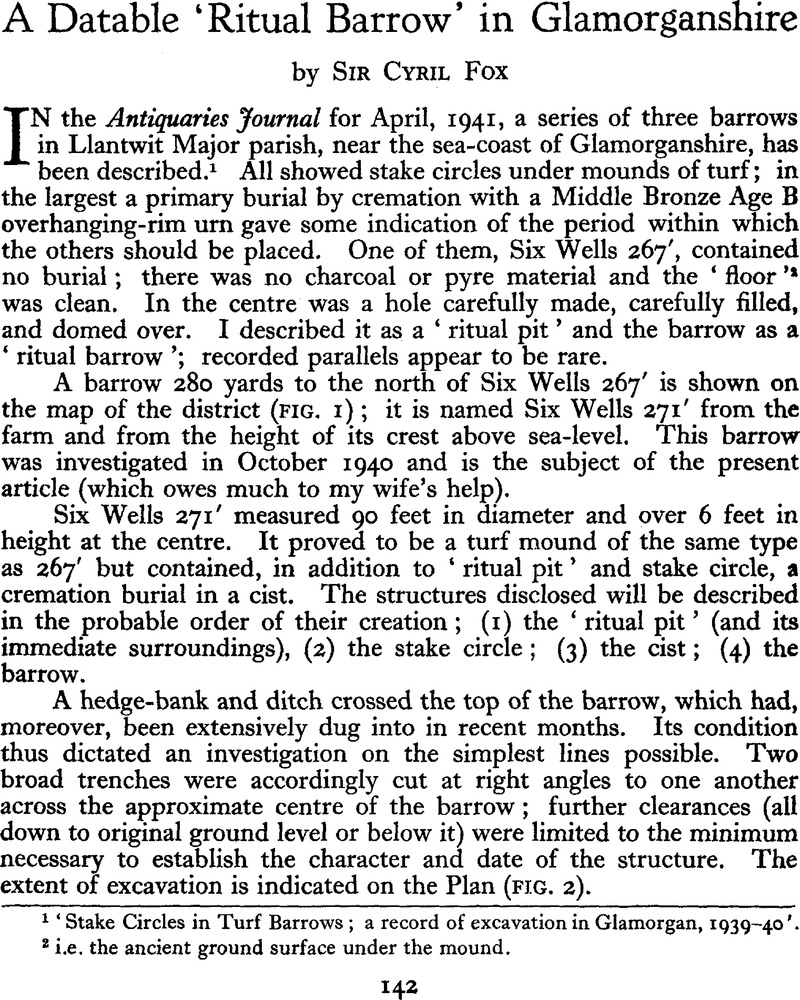Article contents
A Datable ‘Ritual Barrow’ in Glamorganshire
Published online by Cambridge University Press: 02 January 2015
Abstract

- Type
- Research Article
- Information
- Copyright
- Copyright © Antiquity Publications Ltd 1941
References
1 ‘Stake Circles in Turf Barrows; a record of excavation in Glamorgan, 1939-40’.
2 i.e. the ancient ground surface under the mound.
* The circumstances, chemical and physical, which give rise to this layer, are under consideration by Dr F. J. North.
3 Antiq. Journ., loc. cit. p. 119, and plan, pl. XXVIII.
4 An approximation. Its Iimits were not accurately measured.
5 I omit from all future consideration the inner stake-hole of the close-set pair in the northeast quadrant (see Plan).
6 Every care was taken in such cases as these to establish the fact of the gap.
7 All measurements are from centre to centre of the holes.
8 See Antiq. Journ., loc. cit., pp. 101 ff. and 117, where these stake circles are discussed.
9 A not impossible operation, for bronze saws are known in the Late Bronze Age, and flint saws preceded these.
10 One inner slab, which extended diagonaIly downwards from the upper corner on the photograph, was removed before this was taken.
11 For this photograph the lid was replaced on the cist. It was taken some days later than the others, when the whole area had been cleared to ground level and the stake-holes revealed. The Lias limestone dries out white; hence the strong contrast between the structure and the soil.
12 The fine earth which fills the cist in the photograph gained entrance through the many holes and cracks in the structure. The placing of flat stones above and below the urn is a not unusual Bronze Age technique in South Wales. cf. Arch. Camb., 1936, pp. 116-17, and Procs. Soc. Ant., 2s., vol. 11, p. 431, describing the Golden Mile Barrow, Colwinston, Glam., where the practice dates from c, 700 B.C.
13 Procs. Somerset Arch. and Nat. Hist. Soc., 1883, XXIX, p.46. The urn is illustrated in Abercromby, Bronze Age Pottery, 11, no. 464, and, with the fragment of the other urn, is preserved at Taunton Museum. Mr St. George Gray, in addition to his gift of the photo reproduced in pl. IV, has kindly sent me a drawing of the fragment; it is probably from a lugged or loop-handled urn of Late Bronze Age (southwestern) type.
14 Abercromby, B.A.P., II, 456c. The Elworthy urn is included in Mr Christopher Hawkes’ ‘List of Deverel-Rimbury Urns’ in Antiq. Journ., 1933, p: 451. Mr Stuart Piggott kindly informs me that he has obtained from a barrow on Crichel Down near Blandford, an L.B.A. bucket urn with 'just the same very vestigial lugs' as the Six Wells urn shows.
15 e.g. Abercromby, 11, 389c, and 403, both from Dorset. cf. a vessel of somewhat earlier date, from Sussex; Procs. Prehist. Soc., 1935, p. 42.
16 Flared rims of the Elworthy–Six Wells type are certainly not a normal feature of Deverel–Rimbury urns or their native derivatives in Britain, but examples can be found—e.g. in Dorset, associated with a Deverel–Rimbury urn, Abercromby, op. cit. 400 b. A bucket-shaped urn from a cist at Fowey, Cornwall, illustrated in Hencken, Cornwall and Stilly, pl. VIII, 3, and Abercromby, 463, is probably a close relative.
I am much indebted to many friends who have helped me with the problem of the Six Wells urn; Miss Florence Patchett and Mr Christopher Hawkes have kindly provided me with much comparative material, and the investigation has confirmed views expressed by Professor Gordon Childe, Mr Stuart Piggott, and Mr Ralegh Radford.
17 Procs. Som. Arch. and Nat. Hist. Soc., 1896, XLII, pp. 22-3.
18 Antiq. Journ., loc. cit., pp. 99 f., 105 f., 119 and pl. XXIX.
19 I am of course not concerned with the ‘spread’ of the mound due to ploughing, which is extensive and measurable, but of no importance.
20 Preston and Hawkes, ‘Three L.B.A. barrows on the Cloven Way’. Antiq.Journ., 1933, especially pp. 438-9.
21 op. cit. pl. CVII, no. 21.
22 Domed pit, at Breach Farm barrow, c. 1600 B.C. Turf barrow, and stake circles, Sheeplays 293’, c. 1300 B.C.
23 This and the following extracts and comments, are derived from J. E. Harrison, Prolegomena to the Study of Greek Religion, 2nd ed., 1908. The present reference is to p. 125.
24 op. cit. p. 68. Tιταvη was a town in the Peloponnese (in Sicyonia).
25 Varro : see Harrison, op. cit. p. 47.
26 Antiq. Journ., 1941, pl. XIXa.
27 Harrison, op. cit. p. 240. cf. J. L. Myres’ Who were the Greeks?, p. 191, para. 3.
28 Harrison, op. cit. figs. 68-9, pp. 277-8.
29 We know what a dedicatory sacrifice among the Middle Bronze Age folk in South Wales was like; burnt bones thrown into a stony pit. See Archaeologia, LXXXVII, pp. 144-5 (Pond Cairn, Bridgend).
30 The classical parallel I have adduced has been applied before, but from a different angle, and not to elaborate structures such as Six Wells 267’ and 271’. See e.g. Thurnam, Arch. xlii, p. 181, with reference to holes under long barrows, and Mr G. M. Young, ANTIQUITY, 1934, pp. 459-61, with reference to the circular hollows, miscalled ‘Pond Barrows’, found adjacent to barrow groups in Wiltshire.
* The methods of examining materials of this description will be described in an appendix to a forthcoming paper, in Archaeologia, lxxxix, on another barrow of the group: Sutton 268’.
- 1
- Cited by




